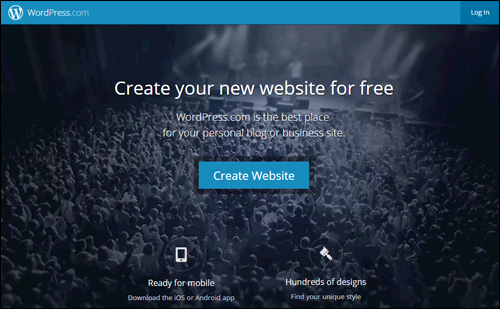
Welcome to Part Three of our WordPress Web Traffic Blueprint article series, where we show you how to drive new traffic automatically to your website using the WordPress CMS platform.
In Part 1 of this series, we explained why using an expertly configured WordPress website is the key to generating automated traffic …
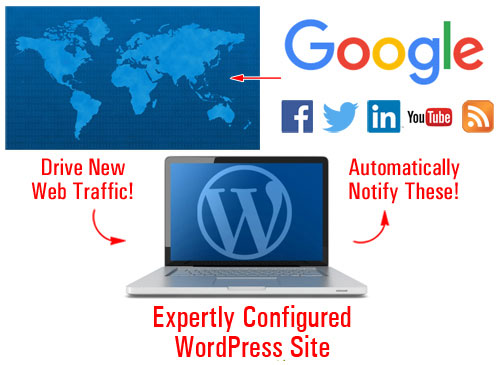
(With an expertly configured WordPress website or blog, all you have to do to automatically begin attracting new web traffic is publish content regularly!)
In Part 2, we discussed critical setup decisions. We helped you understand the best way to get started if you don’t have a web presence yet, how to set everything up if you already have a site, and what to do if your site was built using WordPress.
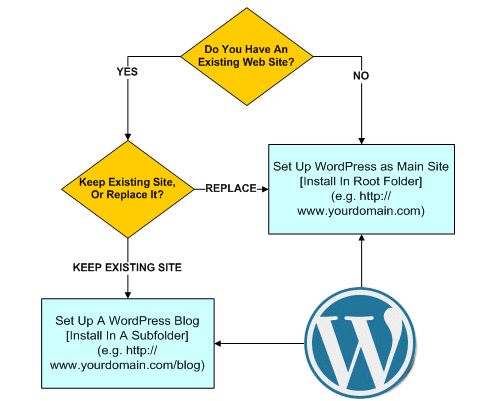
(In Part 2 we show you where to set up WordPress on your domain)
In this section of the series, we look at the configuration phase of the WordPress traffic automation system. We will help you understand what makes an expertly configured WordPress site different from a professionally configured site. You will also discover what kind of work is required to make sure that when all is set up and fully configured, you can begin driving traffic automatically as you start to add new content to your WordPress site.
WordPress Web Traffic Automation System – Configuration Phase
Finding ways to attract more visitors to one’s website is often cited by many website owners as one of their greatest challenges online. With competition becoming increasingly more difficult businesses are looking for any advantage available to improve their results and performance online.
The ability to automatically generate traffic on demand is a huge advantage over the competition. With an expertly configured website, your business has an immediate competitive advantage from the very beginning.
The Configuration Stage Is The Difference
There is a difference between an expertly configured WordPress site and a site that has been professionally set up by an expert website builder but not necessarily configured to its fullest advantage.
Here’s a simple way to describe the differences:
An expertly configured WordPress site gives you a professional web presence plus online business marketing automation!

(An expertly configured website gives you a professional web presence and a built-in automated online business marketing tool!)
Not only does a whole lot more work go into building and integrating an automated online business marketing process into your website, it also takes a special type of expert knowledge.
Allow me to illustrate this with a story.
Are Experts Worth The Money They Charge?
Everything was moving along in the widget-making assembly line when suddenly, all equipment stopped.
As no one could figure out what happened, the floor manager decided to call in an expert.
Promptly after arriving, the expert went immediately to the control box. After staring silently at the wires and circuitry for 5 minutes or less, the expert then took out a tiny hammer and made a single tap near the left edge of the control unit.
Immediately, the assembly line returned to normal.
The floor manager was grateful and relieved as he thanked the expert, who left as quickly as he had arrived.
A few days after resolving the incident, the manager received a request for payment of $5,000.
The factory manager called the expert, demanding to know why he had charged them so much for less than five minutes work and promptly requested an itemized invoice before hanging up.
The next day, an invoice statement arrived on the manager’s desk. Upon opening it, this is what he saw:
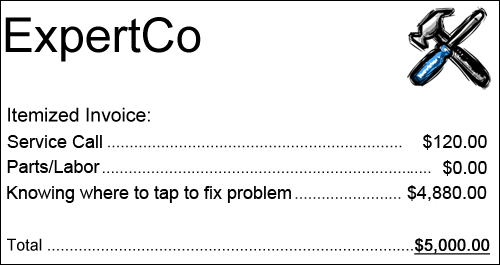
The main challenge most businesses face online is being able to consistently drive traffic to their sites.
In the above story, how much money did the gizmo factory stand to lose when production stopped working and no one on the factory floor was able to get things up and running again? Did the expert in our story not have the right to demand fair compensation for years spent building up the knowledge and expertise that enabled him to fix a costly problem?
Similarly, if you could have a website set up and configured so all you have to do is publish new content and Google, Facebook, Twitter, LinkedIn, Pinterest and dozens of other online properties would be instantly notified, how much time and money would you save?
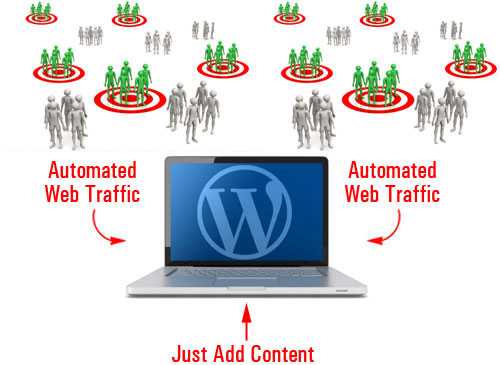
(How much better would your business be if you could automate the process of attracting new visitors to your site?)
Although many experts often make difficult situations and problems look easy, it rarely turns out to be that way.
Expertly configuring a WordPress site is more than adding some pages with content and configuring some basic settings. It also requires knowing where to tap! This includes knowing things such as:
- Which plugins need to be installed to add desired functionalities to your site.
- Which accounts you need to set up to get certain outcomes
- Which options need to be configured to make sure things work as planned, etc.
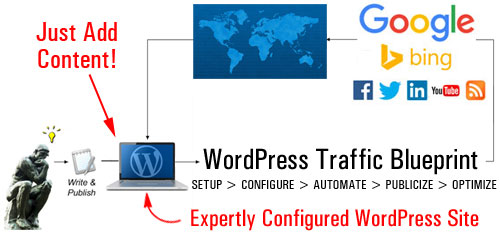
(Driving new traffic automatically with WordPress is a process that requires expertise)
This part of the WordPress traffic automation system is not so technically challenging, but it’s quite complicated. This is because it’s not as simple as installing and configuring a solution, tweaking some options and settings in your dashboard area or clicking a couple of buttons … it’s all this and much more.
Expertly configuring your website is a complex process that involves your web server, your WP site, and various external sites and services …
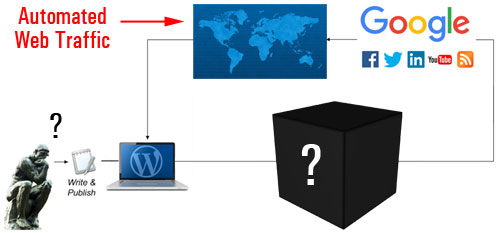
(Expertly configuring your website involves more than just configuring some settings in WordPress)
If we try to flowchart the configuration process, it would look something like this …
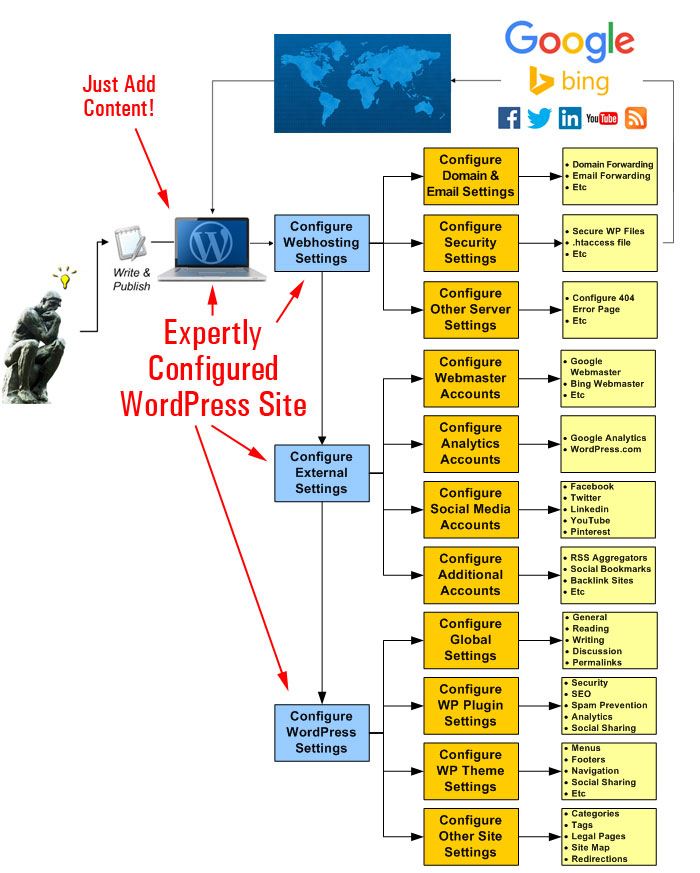
(A simplified diagram showing the activities involved in the configuration process)
Let’s examine these steps in more detail.
Configuring The Server
We’re not talking about the process of configuring your web hosting account for site installation purposes (this is normally done during the Setup phase). We’re talking about configuring settings and options in your web server that affect how your site will handle web traffic …
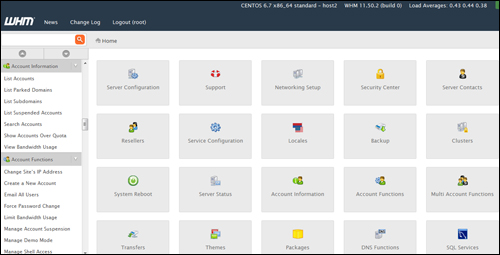
(During the configuration phase, your web-hosting account settings need to be checked for handling both good and bad traffic)
Not all traffic is positive traffic. Some of the traffic you may attract will be unwanted traffic like bot spam, malicious threats, bot-hacking attempts, etc.
This area of the configuration process, therefore, is all about planning for bad and good traffic and adjusting settings in your server accordingly. This includes looking at things like configuring spam protection and securing server files, to configuring your domain and email redirections, setting up htaccess file redirections, etc …
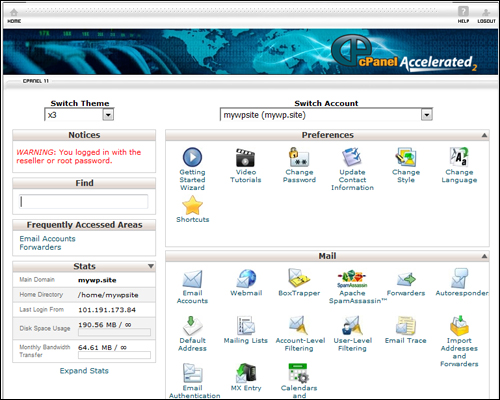
(Have you configured your webhosting settings for handling things like emails, page error redirects, etc?)
After checking your web server settings and configuring these, the next step is to set up and configure various external sites or online services.
External Accounts
The purpose of setting up external sites is that all content will be published from one central location (your WordPress site) and from there, it will syndicate automatically to other components of your web traffic generation system, or notify traffic-related web properties and services.
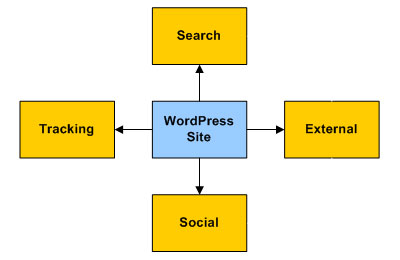
After adding these external sites to your network, content with links pointing back to your website gets automatically syndicated to search, social and aggregator accounts. Your content and website will be exposed to new sources of traffic and new audiences.
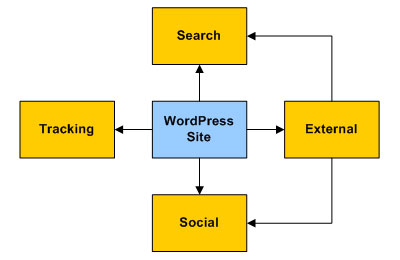
Some of these sites will need to have accounts set up before configuring your WordPress settings to help save time and some will need to be done later, during the automation phase.
For example, you will want to set up the following accounts:
Google Webmaster Tools
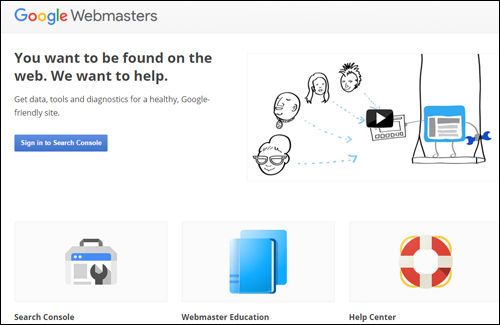
(Google Search Console)
Google Search Console lets you inform Google about your site’s pages, submit XML sitemaps for faster page indexing, and provides you with useful information, tools and reports about your website.
After setting up your account and entering site details with Google, your details can be used to integrate and automate traffic-related settings in WordPress and other applications.
Google Analytics

(Google Analytics)
Google Analytics lets you improve your site’s traffic results, SEO, user engagement, marketing activities, sales conversions, and more, by tracking all user engagement, pages visited, keywords searched for, organic referrers, etc.
Once your Google Analytics account is set up, you can add visitor tracking code to WordPress via plugins and feed data instantly to other applications and web properties.
Bing Webmaster Tools

(Bing Data And Tools)
Bing Webmaster Tools is similar to Google Search Console. Once your account and site data with Bing Webmaster Tools are set up, use this information with web traffic settings in WordPress and other applications.
WordPress.com
(WordPress.com)
As explained in Part Two, WordPress offers both a self-hosted and a hosted option. We recommended choosing the self-hosted WordPress version if you plan to build a professional online presence.
WordPress.com (the hosted option), however, provides a number of useful features, which can be accessed by a number of WordPress plugins. We recommend setting up an account with WordPress.com, therefore, and we’ll show you how to integrate this into your automated traffic generation system in the next installment of this series.
Social Media Pages

(Syndicate your content automatically to your social media and social bookmarking accounts and get new traffic to your site)
You will need your various social accounts set up in order to integrate these with your traffic generation system.
Once you have set up and configured everything, you will be able to syndicate your content automatically to your social media sites and get new visitors to your site.
You should set up accounts with all the big social networks – Facebook, Twitter, LinkedIn, YouTube, Pinterest, etc.

There are lots of social bookmarking sites you can set up accounts with. You don’t need to go crazy, just select the ones that will work with your system and/or content syndication tools.

(You can syndicate your content to lots of social sites. Image source ShareThis.com)
Additional Services, Content Aggregators, Etc.
There are many new online technology platforms and RSS aggregators that can act as second-tier sources of traffic. Some are free or provide free access levels, and some offer a range of pricing plans.
For example, here is a content aggregator that allows you to add an RSS feed from your site …
RebelMouse
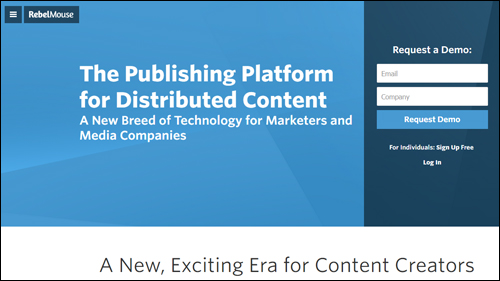
(RebelMouse – Publishing platform for distributed content)
RebelMouse is an aggregator for your RSS feeds and social profiles. Your content displays in a Pinterest-like format and visitors can follow your own RebelMouse account.
![]()
There are many different platforms that can be incorporated into your own traffic blueprint. Please contact us if you need assistance exploring some of these, or to discuss a configuration plan to suit your needs.
After you have configured your web server and set up third-party service accounts, it’s time to configure your WordPress site’s settings.
WordPress Configuration
The first step in configuring your WordPress site for traffic is to ensure that its global settings have been set up correctly.
Let’s go over some of the important points.
Global WordPress Settings
By default, your WordPress administration area includes a Settings menu that allows you to configure your site’s global settings …
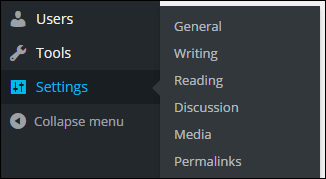
(WordPress settings menu)
General Settings
Sections like Site Title and Tagline can influence your site’s SEO, search results, etc …
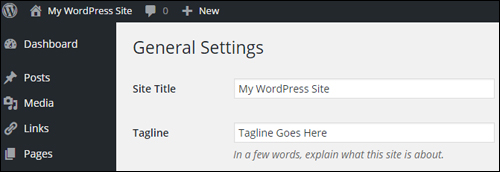
(Global Settings – General Settings Section)
Writing Settings
The Writing Settings section contains one of the most powerful and often overlooked built-in traffic notification systems available to website owners …
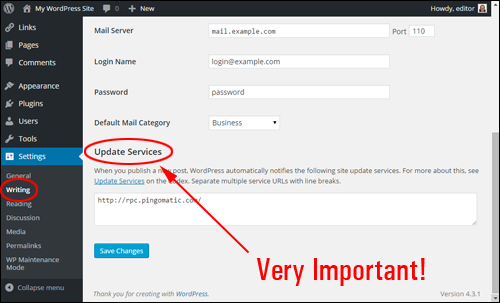
(Global Settings – Writing Settings Area)
As stated in the Update Services section,
When you publish a new post, WordPress automatically notifies the following site update services …
Unless you or your webmaster have purposely configured your site settings to prevent search engines from indexing your site, then your site will automatically notify the list of services entered into the Update Services text box
With an ‘out of the box’ WordPress installation, only one service is available …
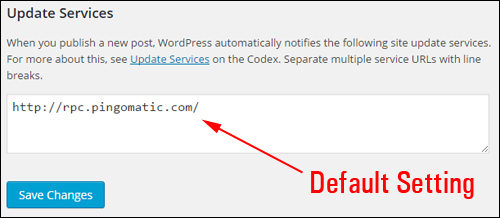
(Writing Settings – Update Services)
WordPress lets you notify dozens of update services automatically – just add a list of all the update services you want to notify as soon as you publish a new post to this section …
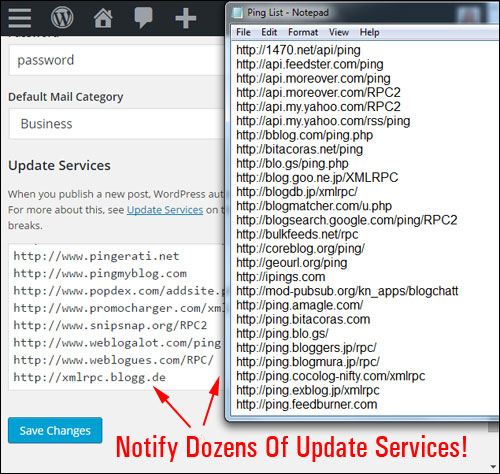
(You can notify dozens of update services automatically with WordPress!)
![]()
Download A Comprehensive List Of Ping Services For Your WordPress Site!
Click the link below to download a comprehensive list of reliable and authoritative ping services for your WordPress site or blog:
Download A List Of Ping Services For Your WordPress Site
***
Note: If you need help setting up the list of ping services on your site, we recommend using a professional web services provider. You can find professional WordPress service providers in our WordPress Services Directory.
Reading
This section affects how your content gets seen by visitors when they visit your home page and blog pages.
The syndication settings on this page can have an influence traffic. For example, your choice to display the full content vs summaries of your post, affects how your content appears in RSS feeds and RSS email campaigns, and could impact someone’s decision to explore your site further, and whether or not they will visit your website to view the rest of the content from summaries, or read the content in full without the need to click through to your site.
As far as your traffic system is concerned, however, the most important setting here is whether the Search Engine Visibility feature is enabled or not.
Typically, you want to encourage search engines to visit your site. Leaving the box unchecked allows your site to ping your list of update services when new posts get published (see Writing Settings above). Unless you have a specific reason to discourage search engines from visiting your site, do not check this box …
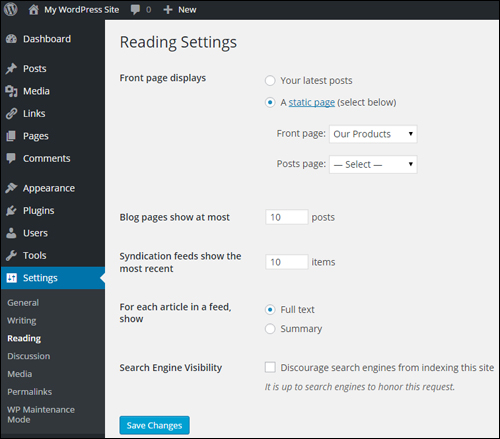
(WordPress Settings – Reading Settings Screen)
Discussion Settings
Although this section is mostly concerned with how users engage with content on your site, you have the option to allow notifications to sites linked to from your posts, and to allow link notifications from other blogs (pingbacks and trackbacks). This can work for you, but it can also drive bad traffic in the form of SPAM comments …
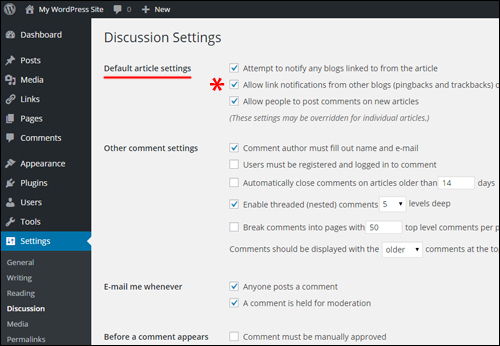
(WordPress Settings – Discussion Settings Screen)
Permalinks
Your Permalink settings allow you to create search engine-friendly URLs …
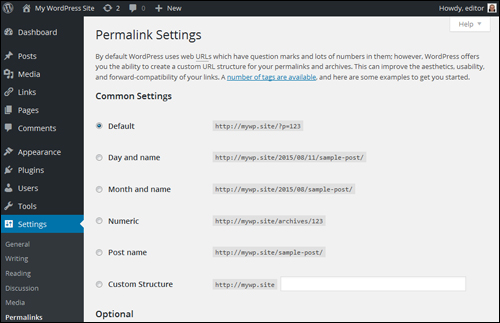
(WordPress Settings – Permalinks)
Here are some of the ways your post permalinks can be configured …
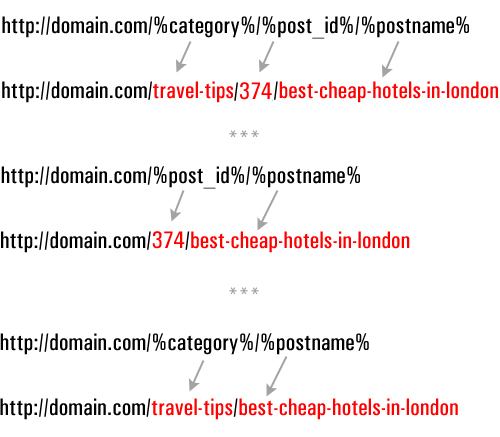
(Configuring post permalinks)
To learn more about setting up WP permalinks, see this step-by-step tutorial: Improve Your WordPress SEO Using SEO-Friendly URLs
WordPress – Traffic Plugins
WordPress provides users with plugins that help to add just about every type of functionality to your website, including plugins with features that help to improve traffic generation.
Here are examples of plugin categories and plugins that can help drive more visitors to your site
Blog Defender
Once again, it’s important to configure your WordPress site for handling both good traffic and bad traffic. No website is completely immune from being targeted.
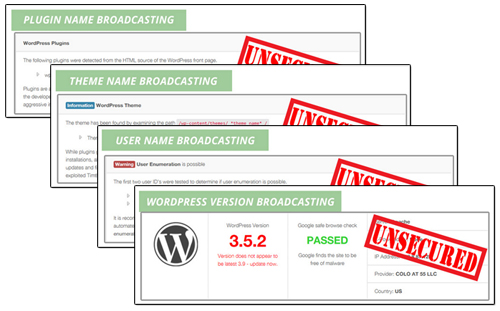 (WordPress Security Plugins stop bad traffic from causing your website harm)
(WordPress Security Plugins stop bad traffic from causing your website harm)
Security plugins like Blog Defender help to make your WordPress blog invisible to hackers and botnets.
Go here for more information:
SEO Plugins – Yoast SEO
SEO plugins help drive more traffic by improving the search engine friendliness of your website …

(WordPress Plugins For SEO – Yoast SEO)
A plugin like Yoast SEO can significantly improve your SEO. When properly configured, the Yoast SEO plugin not only makes your website easier for search engines like Google to index, it also lets you specify how to present your content in Google’s search results and social media sites Facebook, Twitter, and Google+.
WordPress Social Plugins
Allowing visitors to easily share your content with others online can help boost traffic to your site, especially if you provide great content that adds real value to readers.

(You can easily add social sharing buttons to your website using WordPress plugins)
There are many free or inexpensive social sharing plugins to choose from.
Most social share plugins allow you to specify which social sites your content can be shared to, embed social buttons into your content, set up default update notifications, display/hide share counters (e.g. number of followers), etc. Some social sharing plugins even allow you to set up protected content areas on your site which visitors can unlock by linking or tweeting your page.
Configuring WordPress Traffic Features In Themes
As well as configuring various plugins, many WordPress themes also include features that can help improve your site’s traffic generation capabilities.
For example, in addition to options and settings for configuring the design and layout of your site, some themes also give you built-in options for improving SEO and site navigation structure for faster indexing, easily add tracking snippets, social sharing buttons, etc …

(Many themes can be configured for better traffic results)
With a number of WordPress themes, adding social sharing buttons and features to your pages is as easy as clicking a couple of buttons to enable the feature …

(Many WordPress themes include built-in social sharing features)
Configuring Other WordPress Sections
Last (but by no means least) in the web traffic configuration process, are the components that need to be configured outside of the global settings.
These include:
Website Compliance Pages
Once again, when preparing your site for an increase in visitor numbers, it’s important to plan not only how to handle good and unwelcome traffic but also for all the things that can go wrong when more and more people find and begin to visit your website.
If you make money online (or plan to), it’s important that your website is compliant with all laws and regulations.
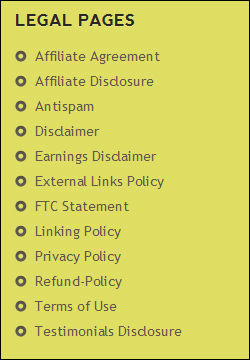 (Does Your Site Comply With All Legal Requirements?)
(Does Your Site Comply With All Legal Requirements?)
We have created a detailed article on how to quickly add legal pages to your website or blog here:
WordPress Post Categories And Tags
Post categories and tags help to improve your site’s search optimization, which improves traffic.
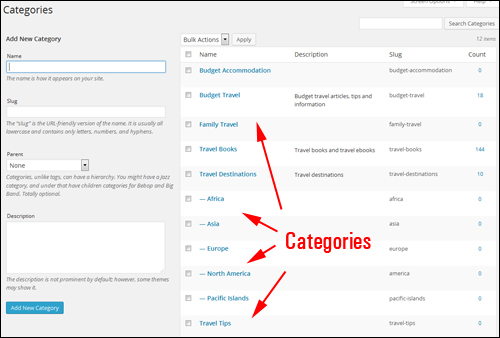
(Categories help improve traffic by allowing search engines to better organize and index your website.)
As we recommend in this article, it’s best to set up your website’s post tags and post categories during the Website Planning Process.
When considering ways to automate and improve web traffic, you will want to review and make sure that your site’s categories and tags have been correctly set up to deliver optimal results.
Add A Site Map To Your WordPress Site
A site map that lists all of your posts and pages is not only a useful navigation tool, it can also help external applications find your website content …
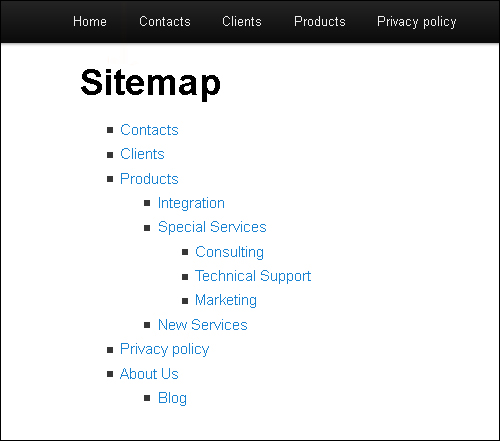
(A site map is not just great for visitors, but for web traffic too!)
![]()
It’s important to note that an HTML site map and an XML sitemap are two different things. Although Google can index your pages just using an XML sitemap (which a plugin like Yoast SEO will create for you – see earlier section), allowing visitors to find more pages on your site can result in increased traffic.
404 Page Not Found – An Additional Source Of Traffic!
When online visitors enter the wrong web address or click on an invalid link, they will normally be presented with an error page …
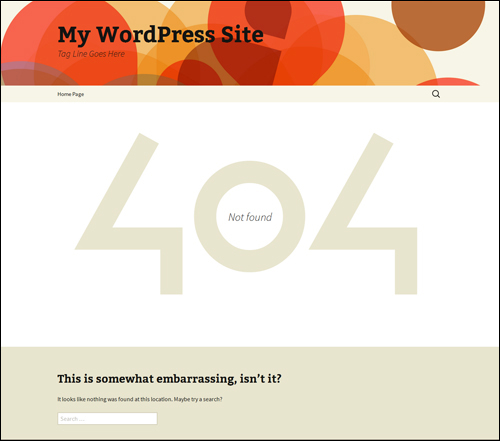
(Default WordPress 404 Error Page)
A 404 page can be configured to redirect confused visitors to your functional web pages …
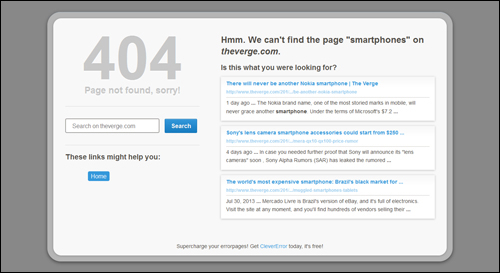
(Configuring your 404 Not Found error page allows you to recover traffic that may otherwise be lost.)
![]()
Although a 404 page can be set up on your server, there are plugins for WordPress that allow you to easily configure your 404 page inside your WordPress admin area.
WordPress Traffic System: Configuration Phase – Summary
Once you have your site expertly configured and fully set up, all you have to do is publish content consistently to automatically begin bringing web traffic organically.
The process of expertly configuring a WordPress site, however, can be quite involved , requiring the configuration and integration of different elements and external web properties …
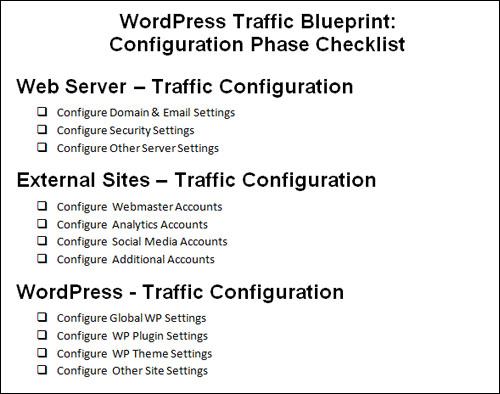
(WP Traffic System – Configuration Phase Checklist)
![]()
The skills and knowledge required to perform this phase of the traffic automation process can take some web developers a long time to learn.
Once you have expertly configured your WordPress site, the next step is to automate the aspects of the process that can be automated. This step is addressed in the next section of our WordPress Traffic Automation System series.
This is the end of Section Three
To read the rest of this article, click here:

![]()
This tutorial is part of a comprehensive tutorial series aimed at helping small business owners learn how to grow their business with a WordPress-driven website or blog and proven web marketing strategies.
Subscribe Using The Form Below And Get Notified When New Tutorials Get Published!
***
"If you're new to WordPress, this can stand on its own as a training course and will stay with you as you progress from beginner to advanced and even guru status." - Bruce (Columbus, Ohio)
***
